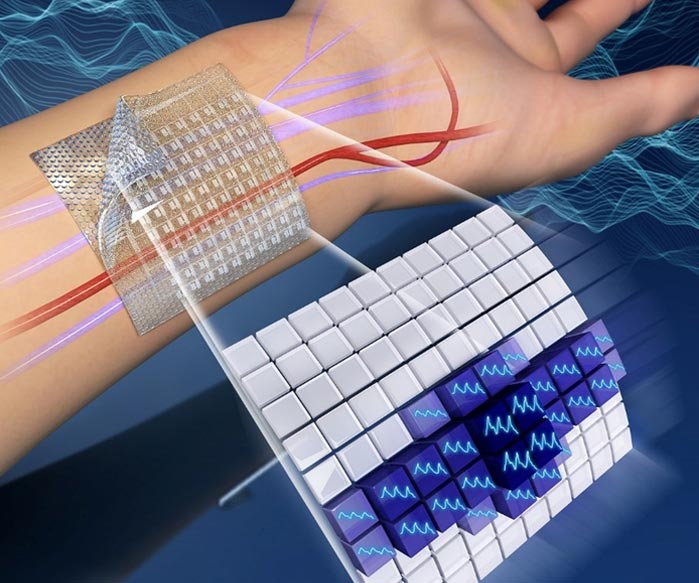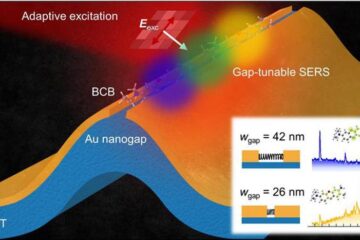Measuring pulse waves with a hair-thin patch

Pulse signal map created by ultrathin wearable sensors with 100 sensing pixels.
Credit: POSTECH
A pulse wave is a wave in which the blood flow – that originates from the heartbeat – is transmitted to the body. It is an important biosignal that indicates cardiovascular health. Analyzing the pulse wave signal can diagnose cardiac conditions including high blood pressure, arteriosclerosis and more. However, conventional pulse wave measuring devices are cumbersome as they require wearing the blood-pressure measuring cuff or stiff tong-shaped sensor and can mostly be performed at hospitals.
Recently, a POSTECH research team led by Professor Sungjune Jung (Department of Convergence IT Engineering and Department of Materials Science and Engineering), Dr. Sanghoon Baek (Department of Convergence IT Engineering), and Professor Sung-Min Park (Department of Convergence IT Engineering, Department of Mechanical Engineering, and Department of Electrical Engineering) in collaboration with Professor Hyunhyub Ko of UNIST (School of Energy and Chemical Engineering) has developed a wearable sensor patch thinner than a hair strand that can measure pulse wave signals with high precision.
What is notable about this research is that the patch was printed using inkjet printing that we are familiar with. This printing technology is also well known as a next-generation semiconductor manufacturing method that can dramatically reduce cost. Using this technology, wearable electronic devices can be made by simply printing conductive ink on a very thin substrate.
First, the research team fabricated a pressure sensor that mimics skin’s tactility and used it to enable physical pulse waves to be detected by the patch just as they are detected by the fingers. The researchers also used a patch-type device with 100 sensor pixels to obtain a two-dimensional (2D) pressure map on the wrist. Conventional wearable pulse wave sensors are designed to measure signals only at a single location, making it difficult to accurately place them on the artery, leading to less precise measurements.
Through experiments, the researchers successfully created a 2D pressure map to accurately obtain the pulse wave signals and analyzed their strengths to locate the invisible arterial blood vessels. Moreover, the researchers developed sensor patches of various sizes by taking age, gender, and body sizes into consideration. Such personalized design was possible by the simple inkjet printing technology.
“This study is significant in that it has demonstrated possible applications of inkjet printing to next-generation customizable wearable devices,” remarked Professor Sungjune Jung of POSTECH.
“The newly developed technology allows for at-home diagnosis of diseases that are usually performed only at hospitals,” explained Professor Sung-Min Park of POSTECH. He added, “it can be used for medical applications such as pre-diagnosis of cardiovascular diseases and arterial catheter injections in daily life.”
Recently published in the international journal ACS Nano, this study was conducted with the support from the Technology Innovation Program funded by the Ministry of Trade, Industry & Energy of Korea (MOTIE) and from the LG Display-POSTECH Incubation program.
Journal: ACS Nano
DOI: 10.1021/acsnano.1c06695
Article Title: Spatiotemporal Measurement of Arterial Pulse Waves Enabled by Wearable Active-Matrix Pressure Sensor Arrays
Article Publication Date: 25-Jan-2022
Media Contact
Jinyoung Huh
Pohang University of Science & Technology (POSTECH)
jyhuh@postech.ac.kr
Office: 82-54-279-2415
All latest news from the category: Medical Engineering
The development of medical equipment, products and technical procedures is characterized by high research and development costs in a variety of fields related to the study of human medicine.
innovations-report provides informative and stimulating reports and articles on topics ranging from imaging processes, cell and tissue techniques, optical techniques, implants, orthopedic aids, clinical and medical office equipment, dialysis systems and x-ray/radiation monitoring devices to endoscopy, ultrasound, surgical techniques, and dental materials.
Newest articles

“Nanostitches” enable lighter and tougher composite materials
In research that may lead to next-generation airplanes and spacecraft, MIT engineers used carbon nanotubes to prevent cracking in multilayered composites. To save on fuel and reduce aircraft emissions, engineers…

Trash to treasure
Researchers turn metal waste into catalyst for hydrogen. Scientists have found a way to transform metal waste into a highly efficient catalyst to make hydrogen from water, a discovery that…

Real-time detection of infectious disease viruses
… by searching for molecular fingerprinting. A research team consisting of Professor Kyoung-Duck Park and Taeyoung Moon and Huitae Joo, PhD candidates, from the Department of Physics at Pohang University…





















